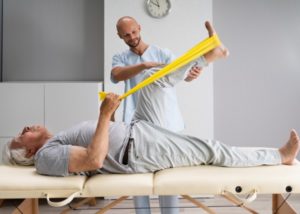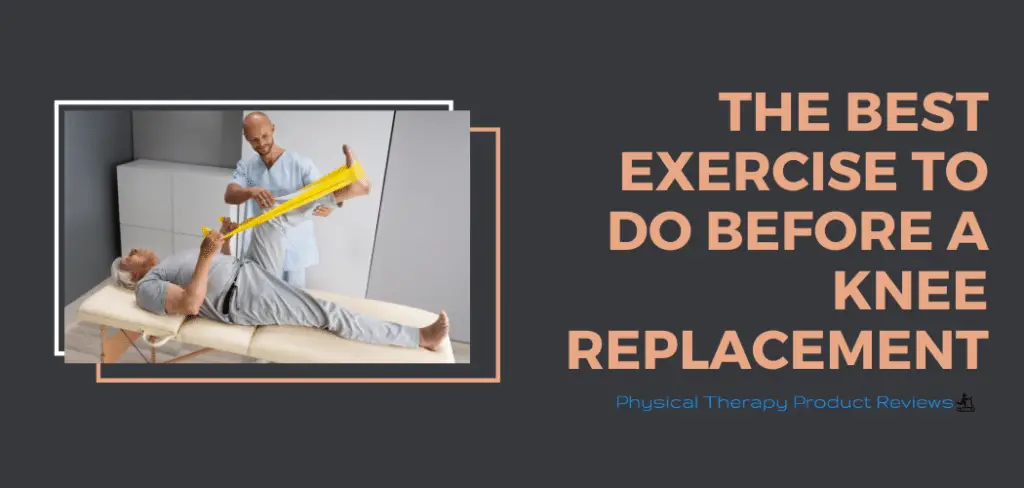We all know the benefits of exercising; increased blood flow, muscle strength, and overall better physical and mental health. Exercising before your total knee replacement is especially important for a quick and successful recovery.
It has been proven that exercising prior to having a total knee replacement speeds up the recovery time significantly by strengthening your heart, lungs, and muscles. These exercises will also increase your range of motion so that you can get back to your regularly scheduled life much sooner than if you sit like a potato and do nothing.
 A surgeon can ‘fix’ your knee, but ultimately if you want your surgery to be successful it is imperative that you follow your doctor’s and physical therapist’s instructions.
A surgeon can ‘fix’ your knee, but ultimately if you want your surgery to be successful it is imperative that you follow your doctor’s and physical therapist’s instructions.
Before and after your total knee replacement it is up to you to take the proper steps to stay healthy and in shape. Nobody can do it for you. Being diligent and staying positive will greatly increase your chance of success.
Who Benefits the Most from Doing Exercises Before Surgery
Just about everyone, that’s the best part! Exercise before a knee replacement has been shown to be beneficial across the board. As already mentioned, pre-surgical exercise improves outcomes, gets you back to sports faster, improves your ROM, and decreases use of pain killers both in amount and how long after surgery you have to take them.
The best part is that the people who are not regular exercises or who have never exercised in their life, actually get the most benefit from pre-hab. So the excuse ” I don’t need to exercise before surgery, I never have and it’s too late,” doesn’t work! Those who are most of shape, the weakest and the most frail are the ones that can make the most gains and lessen the burden from surgery.
The 5 Best Exercises for Maximum Post-op Results
Seated Long Arc Quad
This is a great exercise for strengthening your quadriceps (thigh muscles).
Step 1: Begin by sitting with good posture on a solid chair with your knees bent as close to 90 degrees as possible.
Step 2: Carefully begin to extend your leg out and up until it is straight out. Try not to jerk your leg as you are doing this, use one smooth, controlled motion. Do your best to keep your toes and kneecap pointing straight up at the ceiling. Hold this position for 3-5 seconds if possible.
Step 3: Slowly bring your leg back to the original starting position and repeat 10-15 times if you are able.
Try to do this exercise 2-3 times per day.
Tip: For added resistance/difficulty is to add ankle weights or use resistance bands.
Seated Hamstring Curl
This exercise is designed for strengthening your hamstrings (the four muscles that connect to the back of your knee). For this exercise, you will need a resistance band and something to hook it to, such as a table leg or something else that can withstand being pulled against.
Step 1: Set your chair in front of the table and hook the resistance band to the leg. Be sure that you have enough room to extend your leg freely without kicking the table.
Step 2: Begin by sitting with good posture on a solid chair with your knees bent as close to 90 degrees as possible.
Step 2: Slightly extend your leg than in a gentle and controlled movement, slowly pull your back until it is almost under your hips
Step 3: Hold this position for 2-3 seconds, return your leg to its original position, and repeat 10-15 times if possible.
Try to do this exercise 2-3 times per day.
Standing 4 Way Hip
These exercises are very important for strengthening your hips which will in return take the stress off of your knees when you are walking or running.
These exercises will require a resistance band, however, if you do not have one or it is too painful, you can still go through the motions. Basically, you will be swinging your leg from side to side and back and forth in smooth controlled motions using resistance bands.
Standing hip abduction – outward
Slightly angle your leg outward. While keeping your leg locked, and in a gentle controlled motion raise your leg outward to the side. Gently bring the leg back to the starting position and repeat 10-15 times if you are able.
Standing hip adduction – across the body
Follow the same steps as the outward exercise; however, Instead of swinging your leg out to the side you will be bringing your leg across to the other side almost as if you are going to cross your legs then change your mind. Once again, try to repeat this movement 10-15 times if possible.
Standing hip flexion
Anchor the resistance band directly behind you. Lock your leg and in a smooth, controlled motion ‘kick’ your leg straight up. Pretend you are going to kick a ball, but don’t bend your knee. Bring your leg back to its original position and repeat 10-15 times if possible.
Standing hip extension
Anchor the resistance band directly in front of you. Instead of ‘kicking’ upward you will be pulling your leg back. Do this 10-15 times if possible.
Keep your leg straight as possible in the locked position for all of these exercises. The key is to use smooth controlled movements.
Straight Leg Raise
This can be a difficult exercise for many people. Do the best you can and remember to keep your leg as straight as possible.
Step 1: Begin by lying flat on your back.
Step 2: Bend the knee that you are not having surgery on.
Step 3: Keep the opposite leg straight and locked. In a controlled movement raise your leg until it is even with the top of the other bent knee. Slowly lower your leg and repeat 3-5 times if possible.
Step 4: Do the same thing with the opposite leg.
Try to do this exercise 2-3 times per day.
Seated Prolonged Extension Stretch
There are two ways to accomplish this stretch. Which way you choose depends entirely upon your level of pain. The purpose of this stretch is to help you open your knee so that it has more extension.
Type 1 Seated position: Sit in a straight-back chair. Find something that you can set your foot on to keep your leg parallel, such as another chair. Gently set your foot upon the chair. Allow your leg to relax and let your knee ‘drop’. It is recommended to use something weighted and lay it above your knee while you have it up on the chair. This weight will help to push your knee down and stretch it. Try to do this for at least five minutes.
Type 2 Stomach position: Lie on your bed flat on your stomach. Hang your legs off of the bed keeping the edge of the bed just above your knee. The knee should be hanging off of the bed. Allow your leg to relax and let gravity help to stretch the knee. If you are able to tolerate the pain it is also recommended to use a weight around your ankle while doing this stretch to get maximum results.
Either of these methods will help you regain your range of motion. Choose what feels best for you and your needs.
Should You Push Through Pain?
Many people use the excuse that “It hurts too much when I exercise”. There will of course be some level of pain when exercising especially if you have an injury that requires surgery. The question is; when should you push through the pain and when should you stop?
Ultimately you’re going to have surgery to ‘fix’ your knee. Keep this in mind, because most likely you are not going to do any more damage than has already been done, so the recommendation is that you should try to push through the pain.
Use common sense. If you are in so much pain that you are brought to tears and cannot push through any longer then you should contact your doctor to see if there are any other things that you can do to strengthen and prepare for your surgery that may not be as painful.
FAQ Regarding Pre-hab for A Total Knee Replacement
Does doing exercises for my knee improve recovery after surgery?
Absolutely! Thats the main reason we recommend doing exercises before surgery. Performing range of motion and strengthening exercise prior to surgery has shown to improve pain levels, speed up recovery, and use less pain killers after surgery.
Can I do damage to my knee by exercising before surgery?
 No not really. If you are already planning to have surgery then there is no more damage that you are going to do with these simple yet effective exercises. We strongly encourage doing as much as you can without pushing into severe pain.
No not really. If you are already planning to have surgery then there is no more damage that you are going to do with these simple yet effective exercises. We strongly encourage doing as much as you can without pushing into severe pain.
My knee is swelling with exercises, should I wait until after surgery to exercise?
Some swelling is ok with exercises, especially if your knee is needing surgery to fix it. There is one caveat, we don’t want too much swelling to the point that is causes the muscles to shut off and you begin to limp. This muscle inhibition can be a pain after surgery if it is prolonged.
How often should I do my knee exercises before surgery?
We recommend performing these daily if you can or as much as you can up to surgery. Exercise is beneficial to the whole body and the mind so its only a benefit and very little downside to performing the exercises as much as you can.
Prevent Poor Performance with Proper Exercising
You know your body better than anyone and know what your limitations are. If you do the best you can to strengthen your muscles before your total knee replacement you will be back to your regular life before you know what happened.
Other Great Rehab Related Articles
How to Stay Active After Cervical Fractures: Expert Tips and Advice
Dealing with Painful Stairs After Ankle Replacement Surgery
Walking After a Total Ankle Replacement: Tips for a Successful Recovery
Exercises While Non-Weight Bearing After Ankle Replacement: Elevation, AROM, Leg Raises, and More
Ankle Pain with Stairs: Causes and Home Treatment Options
5 Common Mistakes You’re Making After an Ankle Sprain
Disclaimer: The information provided in this post is for educational purposes only. This is not a substitute for a medical appointment. Please refer to your physician before starting any exercise program.








